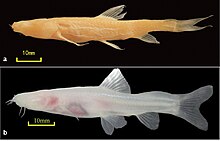
Acrossocheilus is a genus of ray-finned fishes in the family Cyprinidae, native to freshwater in China, Taiwan, Laos, and Vietnam. They are fairly small, no more than 30 cm (1 ft) in standard length.

Cordycepin, or 3'-deoxyadenosine, is a derivative of the nucleoside adenosine, differing from the latter by the replacement of the hydroxy group in the 3' position with a hydrogen. It was initially extracted from the fungus Cordyceps militaris, but can now be produced synthetically. It is also found in other Cordyceps species as well as Ophiocordyceps sinensis.
Sinocyclocheilus is a genus of freshwater fish in the family Cyprinidae that is endemic to Guangxi, Guizhou and Yunnan in China. Almost all of its species live in or around caves and most of these have adaptions typical of cavefish such as a lack of scales, lack of pigmentation and reduced eyes. Several species have an unusual hunchbacked appearance and some of the cave-dwellers have a "horn" on the back, the function of which is unclear. In contrast, the Sinocyclocheilus species that live aboveground, as well as a few found underground, show no clear cavefish adaptions. They are relatively small fish reaching up to 23 cm (9.1 in) in length. The individual species have small ranges and populations, leading to the status of most of the evaluated species as threatened. Many species populations in the genus have yet to be evaluated by the IUCN.
Oreonectes is a genus of fish in the family Nemacheilidae found in the rivers and caves of Asia. Many of these species are troglobitic.

Triplophysa is a genus of fish in the family Nemacheilidae found mainly in and around the Qinghai-Tibet Plateau in China, as well as inland waters of the larger part of central Asia. They can be distinguished from other genera of Nemacheilidae by marked sexual dimorphism, including the development of nuptial tubercles on breeding males. Currently, the genus is a mixed assemblage of species. Some lineages have been identified and treated as subgenera, but as Wikipedia follows Fishbase for fish species all but Hedinichthys have been treated as subgenera in Wikipedia, although Kottelat in his revision of the loaches did recognise them as valid. FishBase, however, includes these in Triplophysa without specifying subgenera and treats the names given by Kottelat as synonyms.

Yunnanilus is a genus of small stone loaches that are endemic to southeastern China, especially Guangxi and Yunnan. They are found in rivers, streams and lakes; some species are restricted to caves.

Cinanserin (INN) is a 5-HT2A and 5-HT2C receptor antagonist which was discovered in the 1960s.
Homatula is a genus of stone loaches endemic to China.

The Han Triumph, also known as Wind Ode, is a Chinese television series based on historical events in the early Han dynasty, beginning with the founding of the dynasty by Liu Bang after his triumph over Xiang Yu, and the events leading to the reign of Liu Heng. Directed by Huang Jianzhong, the series starred Ray Lui, Wang Ji, Liu Mu, Zhang Guangbei, Chen Wei and Li Qingxiang in the leading roles. It was first broadcast on CCTV-8 in China on 17 December 2011.

The Nemacheilidae, or stone loaches, are a family of cypriniform fishes that inhabit stream environments, mostly in Eurasia, with one genus, Afronemacheilus found in Africa. The family includes about 790 species.
The Legend of Crazy Monk is a Chinese television series about the life of Ji Gong. The series was directed by Lin Tianyi and based on Guo Xiaoting's classical novel Biography of Ji Gong. It was a hot TV series recently in Guangdong Television, Jiangsu Television and Shenzhen Television. It is shown on Mediacorp Channel 8 at 7pm.
Triticum urartu, also known as red wild einkorn wheat, and a form of einkorn wheat, is a grass species related to wheat, and native to western Asia. It is a diploid species whose genome is the A genome of the allopolyploid hexaploid bread wheat Triticum aestivum, which has genomes AABBDD.

Sushi domain containing 2 is a protein located in the plasma membrane that, in humans, is encoded by the SUSD2 gene.
Kang Zhang is a Chinese-American ophthalmologist specializing in ophthalmic genetics and aging processes in the eye. He is currently a Professor of the Faculty of Medicine at Macau University of Science and Technology. He was previously a Professor of Ophthalmology and the Founding Director of the Institute for Genomic Medicine at the University of California, San Diego. Zhang is particularly known for his work on lanosterol, stem cell research, gene editing, and artificial intelligence.

The Sinopharm WIBP COVID-19 vaccine, also known as WIBP-CorV, is one of two inactivated virus COVID-19 vaccines developed by Sinopharm. Peer-reviewed results show that the vaccine is 72.8% effective against symptomatic cases and 100% against severe cases. The other inactivated virus COVID-19 vaccine developed by Sinopharm is the BIBP vaccine (BBIBP-CorV) which is comparably more successful. 1 billion doses are expected to be produced per year.
The human identical sequence (HIS) is a sequence of RNA elements, 24-27 nucleotides in length, that coronavirus genomes share with the human genome. In pathogenic progression, HIS acts as a NamiRNA (nuclear activating miRNA) through the NamiRNA-enhancer network to activate neighboring host genes. The first HIS elements was identified in the SARS-CoV-2 genome, which has five HIS elements; other human coronaviruses have one to five. It has been suggested that these sequences can be more generally termed "host identical sequences" since similar correlations have been found between the genome of SARS-CoV-2 and multiple potential hosts (bats, pangolins, ferrets, and cats).

Boulenophrys is a genus of frogs in the family Megophryidae. They occur in the China, Mainland Southeast Asia and Northeast India. It had been placed variously as a subgenus or synonymy of Megophrys. Dubois, Ohler and Pyron first recognized that Panophrys is preoccupied and employed Boulenophrys as the generic name rather than Tianophrys under the Principle of First Revisor.
Karstinnectes is a genus of freshwater ray-finned fishes belonging to the family Nemacheilidae, the stone loaches. The fishes in this genus are cavefish found in China.









